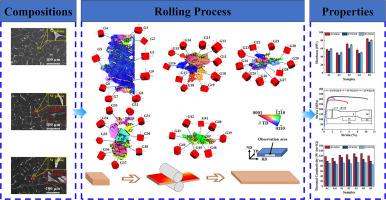稀土/锌原子比对Mg-Zn-Gd-Y合金轧制过程显微组织的影响:一种新的高强高导热镁合金成分设计策略
IF 13.8
1区 材料科学
Q1 METALLURGY & METALLURGICAL ENGINEERING
引用次数: 0
摘要
高强度、高导热镁合金薄板的设计面临着强度与导热系数的内在矛盾以及轧制过程中涉及的复杂变量的挑战。本研究通过调整稀土元素与Zn的原子比,制备了Mg-xZn-0.5Gd-0.5Y (at.%) (1/x = 0.5, 1.0, 1.5)合金。在随后的多道次热轧工艺中,得到了各种因素对不同成分合金组织和综合性能的影响。随着RE/Zn原子比的降低,W相逐渐占主导地位,保证了整个制备过程的高导热性。此外,每道次的厚度减小通过影响合金的析出相、位错和晶粒而对合金的性能起决定性作用。孔道间再加热通过双致静态再结晶机制在整个轧制过程中起协调作用。研究结果表明,利用高导热镁合金每道次的大减薄和有效协调应变积累的优势,是逐步提高高导热镁合金强度,最终获得优异综合性能的可行策略。本研究为高强高导热镁合金轧制薄板的成分设计和工艺优化提供了系统的研究成果,有助于推动该领域的性能突破和应用拓展。本文章由计算机程序翻译,如有差异,请以英文原文为准。

Effect of RE/Zn atomic ratio on the microstructure of Mg-Zn-Gd-Y alloys during rolling process: A new composition design strategy for high-strength and high-thermal-conductivity magnesium alloy
The design of high-strength and high-thermal-conductivity magnesium alloy sheets is challenged by the inherent contradiction between strength and thermal conductivity, as well as the complex variables involved in the rolling process. In this study, Mg-xZn-0.5Gd-0.5Y (at.%) (1/x = 0.5, 1.0, 1.5) alloys were developed by adjusting the atomic ratio of rare earth (RE) elements to Zn. In the subsequent multi-pass hot rolling process, the influence of various factors on the microstructure and comprehensive properties of alloys with different compositions was obtained. With the decrease of RE/Zn atomic ratio, the W phase gradually dominates, which ensures the high thermal conductivity throughout the preparation process. Additionally, the thickness reduction per pass plays a decisive role in the properties of alloys by affecting the precipitates, dislocations and grains. The reheating between passes plays a coordinating role in the whole rolling process through the twin-induced static recrystallization mechanism. The findings indicate that leveraging the advantages of large thickness reduction per pass and effectively coordinating strain accumulation is a viable strategy for progressively enhancing the strength of high-thermal-conductivity magnesium alloys, ultimately leading to superior comprehensive performance. This study provides systematic research results for the composition design and process optimization of high-strength and high-thermal-conductivity magnesium alloy rolled sheets, which is helpful to promote the performance breakthrough and application expansion in this field.
求助全文
通过发布文献求助,成功后即可免费获取论文全文。
去求助
来源期刊

Journal of Magnesium and Alloys
Engineering-Mechanics of Materials
CiteScore
20.20
自引率
14.80%
发文量
52
审稿时长
59 days
期刊介绍:
The Journal of Magnesium and Alloys serves as a global platform for both theoretical and experimental studies in magnesium science and engineering. It welcomes submissions investigating various scientific and engineering factors impacting the metallurgy, processing, microstructure, properties, and applications of magnesium and alloys. The journal covers all aspects of magnesium and alloy research, including raw materials, alloy casting, extrusion and deformation, corrosion and surface treatment, joining and machining, simulation and modeling, microstructure evolution and mechanical properties, new alloy development, magnesium-based composites, bio-materials and energy materials, applications, and recycling.
 求助内容:
求助内容: 应助结果提醒方式:
应助结果提醒方式:


